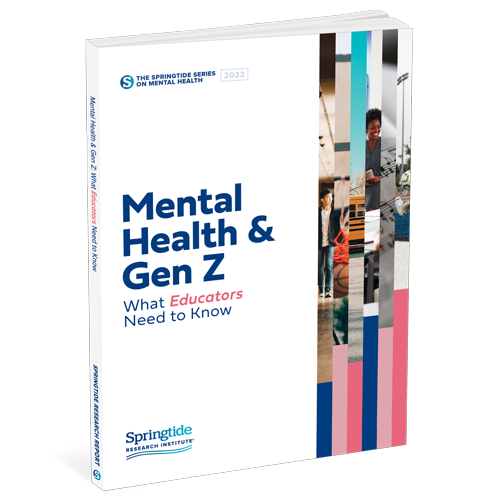
How educators can support students’ mental health
Many schools focus on responding to the immediate mental health needs of young people; this is important given the dramatic rise in mental health concerns of young people over the last several years. Springtide’s research also focuses on what can be done to cultivate spaces that promote mental wellness for young people. As young people already spend most of their time in schools, these spaces—and the adults within them—represent an ideal place to promote mental and emotional flourishing. With young people returning to schools across the country, teachers, staff, and administrators can focus on elements that create a sense of thriving for students.
When we surveyed more than 4,000 students across the US and interviewed dozens more for Mental Health and Gen Z: What Educators Need to Know, 34% of high schoolers said they were not flourishing in their mental health. Only 41% of students agreed with the statement “I have at least one adult that I trust at my school,” and only 18% said they feel safe enough to talk about what really matters to them. One in three students said they feel lonely at school often or most of the time.
While our data show schools succeed in prioritizing the following elements for mental-health friendly environments, it also highlights opportunities where schools can further improve.
Connection
Schools help young people feel connected in basic ways, such as acknowledging students’ presence and establishing rapport with them, yet many students don’t have adults they trust and can be their full selves with—young people tell us this is essential for their mental health.
Expectations
Young people feel that schools help them achieve by providing the necessary tools and explaining what is needed to succeed. Yet, 68% of young people we surveyed agreed with the statement “only certain types of students can really thrive at school.” Clear and achievable expectations, including the sense that all young people can meet the mark, are critical for mental health.
Purpose
Sixty percent of young people agreed with the statement “My school helps me figure out what I’m passionate about.” While they understand their purpose at school is to learn, they appreciate the opportunity to find connection to something meaningful. Finding purpose can help promote mental health among students.
Our data show the power of having trusted adults and the impact of cultivating belonging and purpose in supporting young people’s mental health. Use the following questions to evaluate how you can help create mental-health friendly environments this school year:
- Think about the relationships, groups, and organizations where you feel noticed, named, and known. What is it about those places that makes you feel like you belong? How might you translate these practices into the school environment to foster a sense of belonging for all students?
- What are the “types” of students who really thrive at your school? Which students seem poised to succeed? in light of set or perceived measures of success? Which students seem left out or under resourced? How might you connect with those students?
- How can you demonstrate to young people that they are welcome to be their full selves in your presence?
- What is important to the students you work with? Where do your students find their purpose? How can you integrate their interests with the mission of your school, department or classroom?
- What are you doing as an individual to build trust with the young adults in your care? What is your school doing to build that trust?
- What support or training do adults in your school need to feel more comfortable with the idea of being a trusted adult? Does your institution offer any resources, training or opportunities toward these efforts? How can your school better support you in this process?
Mental Health & Gen Z: What Educators Need to Know
What if you could build a mental health friendly culture at your school instead of just responding to mental health crises? This report, pulled from over 4,000 surveys and 80 interviews with young people ages 13 to 25 shows exactly what young people need in order to thrive in their schools.




